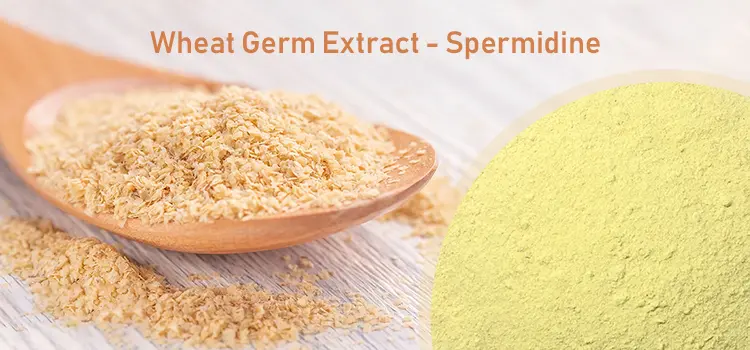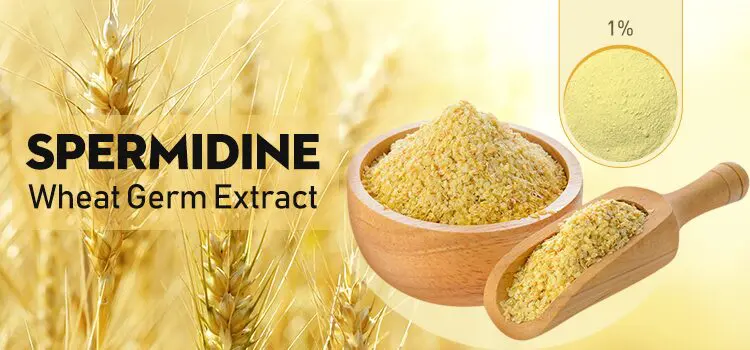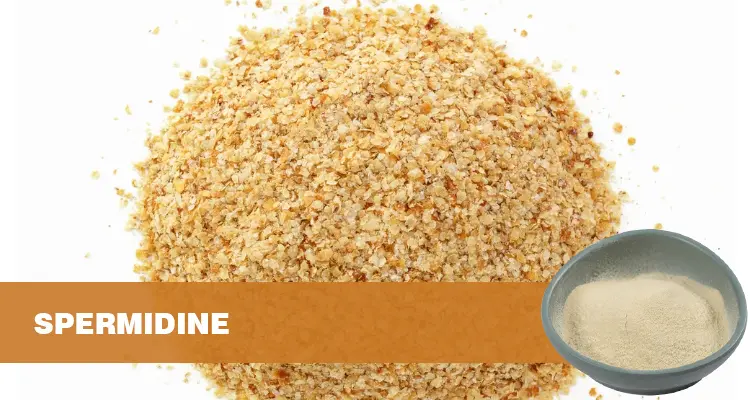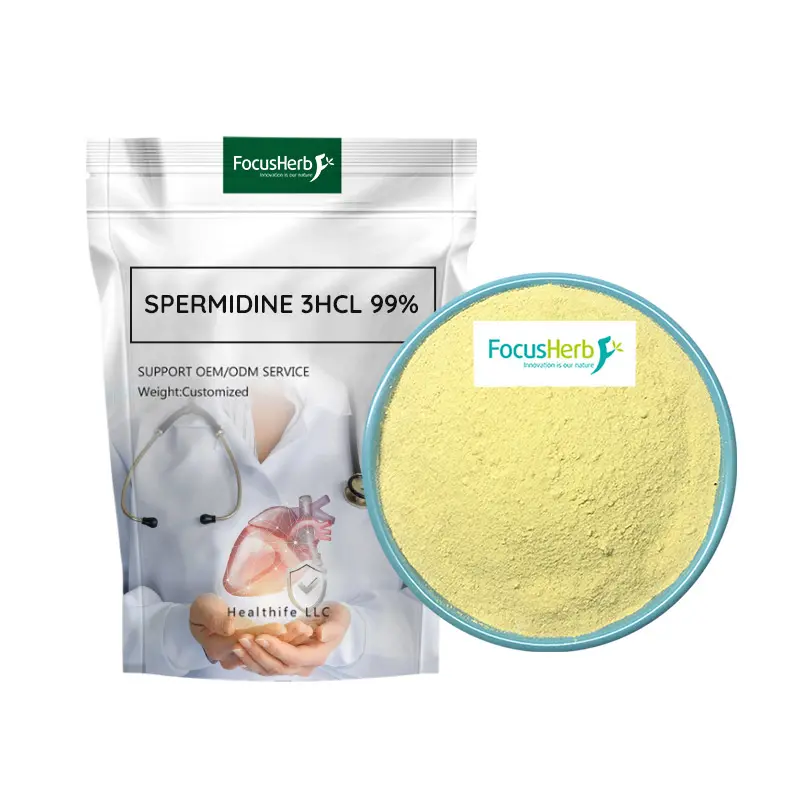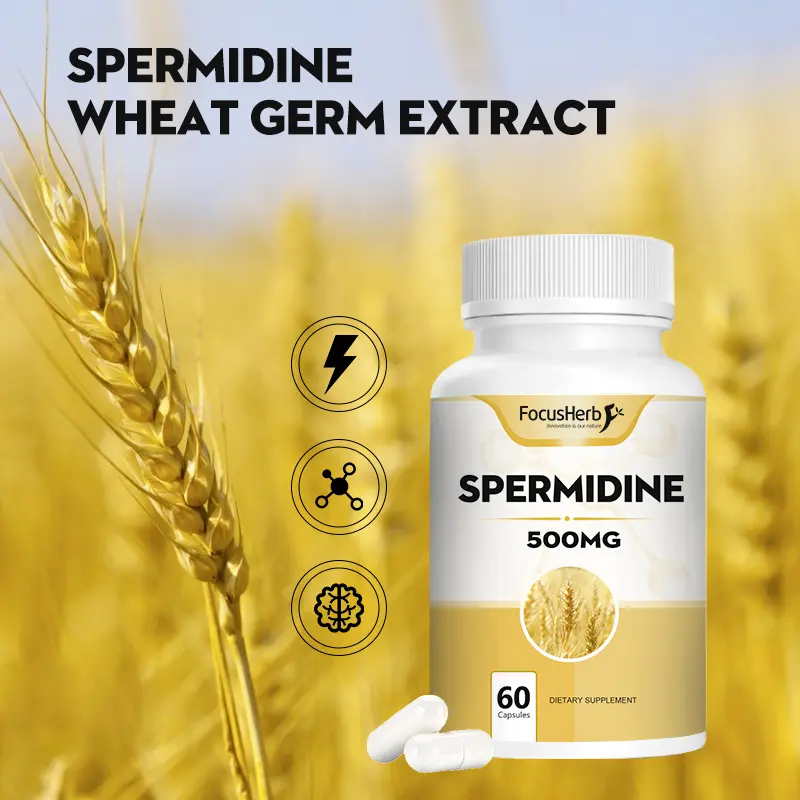Spermidine, a core member of the polyamine family, plays a crucial role in safeguarding cellular homeostasis. It is a small molecule polyamine naturally occurring in the human body, with the chemical structure N-(3-aminopropyl)-1,4-butanediamine. This unique structure endows spermidine with numerous remarkable biological functions.
Spermidine is not just an ordinary intracellular substance; it is also a crucial regulator of the critical physiological process of autophagy. Autophagy functions as a cellular “cleaning and repair system,” clearing damaged organelles, misfolded proteins, and other metabolic waste, thereby maintaining normal cellular function and internal stability. Spermidine acts as the “commander” of this system, regulating the expression of autophagy-related genes and signaling pathways to ensure the efficient operation of the autophagy process.
With aging, spermidine levels in the human body decrease. This change is closely associated with aging and the development of various age-related diseases. Studies have shown that spermidine levels in patients with many age-related diseases, such as cardiovascular disease, neurodegenerative diseases, and diabetes, are significantly lower than in healthy individuals. This has made spermidine a key intervention target for delaying aging, preventing, and treating age-related diseases, attracting widespread attention from researchers and medical experts.
Wheat Germ: A High-Quality Natural Source of Spermidine
In the search for abundant natural sources of spermidine, wheat germ stands out as a shining star. Wheat germ, the “life treasure” hidden within the wheat seed, is the nutrient source for wheat germination and growth. It is rich in numerous nutrients beneficial to the human body, with spermidine being a prominent one.
Research data shows that the spermidine content in wheat germ is as high as 0.8-2.4 mg/g, far exceeding that of other common plant-based foods. For example, compared to common grains, vegetables, and fruits, the spermidine content in wheat germ can be several times, or even dozens of times, higher. This makes wheat germ an ideal raw material for spermidine extraction.
To obtain high-purity and highly active spermidine from wheat germ, researchers have developed a series of advanced extraction processes. Currently, the most commonly used method is ethanol extraction combined with chromatographic purification. First, using ethanol as an extraction solvent, spermidine from wheat germ is fully dissolved and extracted under specific temperature and time conditions. Ethanol has excellent solubility and safety, effectively extracting spermidine while minimizing its activity. Then, chromatographic purification techniques, such as macroporous resin chromatography and silica gel column chromatography, are used to further separate and purify the extract, removing impurities and other interfering components to achieve a purity exceeding 99%.
This extraction process not only efficiently yields high-purity spermidine but also maximizes its natural activity. Furthermore, strict production controls and quality testing ensure that the extract is free of substances that may cause allergic reactions, such as gluten, making wheat germ extract an ideal source for functional foods and pharmaceutical ingredients. Whether as a nutritional supplement added to foods or in the development of innovative therapeutic drugs, spermidine from wheat germ extract demonstrates significant potential for application.
Core Mechanisms of Cellular Repair: From Autophagy Activation to Damage Clearance
(I) Activating Autophagy: The Molecular Switch for Clearing the “Garbage” of Aging
Autophagy is a highly conserved self-degradation and recycling mechanism within cells, playing a crucial role in maintaining a stable intracellular environment, responding to various stresses, and delaying aging. Spermidine acts like a magical “molecular switch,” precisely activating this crucial process.
Spermidine primarily activates autophagy by upregulating the expression of a series of autophagy-related genes. Among them, the protein encoded by the ATG5 gene plays an essential role in the formation of autophagosomes. It participates in the extension and closure of the autophagosome membrane, ensuring that the autophagosome can completely encapsulate damaged organelles, misfolded proteins, and other metabolic waste within the cell. When spermidine is applied to cells, the expression level of the ATG5 gene increases significantly, thereby promoting the formation of large numbers of autophagosomes. The LC3 gene is also crucial. Its expressed product, LC3 protein, undergoes a transformation during autophagy, from a soluble form (LC3-I) to a membrane-bound form (LC3-II). LC3-II is tightly bound to the autophagosome membrane, becoming the hallmark protein of the autophagosome. Its abundance directly reflects the level of autophagic activity. Spermidine can upregulate LC3 gene expression, increasing the conversion of LC3-I to LC3-II, further enhancing autophagic activity.
These activated autophagy-related genes work synergistically to promote the fusion of lysosomes and autophagosomes, forming autolysosomes. Within the autolysosomes, various hydrolases completely degrade encapsulated substances. The resulting small molecules, such as amino acids and fatty acids, are then reabsorbed and utilized by the cell, providing essential raw materials for normal cellular metabolism and function.
Research related to this, which was awarded the 2016 Nobel Prize in Physiology, provides a solid theoretical basis for spermidine’s role in activating autophagy. This study confirmed that spermidine can effectively slow the aging process in model organisms such as yeast and nematodes by activating autophagy. Subsequent in-depth studies in human cell models revealed a surprising finding: the proportion of senescent cells decreased significantly by 37% after spermidine treatment. This data clearly demonstrates the powerful effect of spermidine in eliminating senescent cells and maintaining cellular youthfulness by activating autophagy.
(II) Mitochondrial Repair: Reshaping the Core of Energy Metabolism
Mitochondria, the “energy factories” of cells, shoulder the vital responsibility of providing energy for cellular life. However, during normal cellular metabolism, mitochondria are highly susceptible to damage from various internal and external factors, such as reactive oxygen species (ROS) and genetic mutations. Damaged mitochondria not only lead to insufficient energy supply but also release a large number of apoptotic signals, triggering cell death. Therefore, mitochondrial repair is crucial for maintaining normal cellular function and survival.
Spermidine has demonstrated remarkable ability to repair damaged mitochondria, primarily by activating mitophagy mediated by the PINK1/Parkin pathway. When mitochondria are damaged, their membrane potential decreases, and PINK1 accumulates and becomes activated on the outer mitochondrial membrane. Activated PINK1 recruits Parkin from the cytoplasm to the surface of damaged mitochondria. Parkin, a ubiquitin ligase, ubiquitinates proteins on the outer mitochondrial membrane, marking damaged mitochondria.
The presence of spermidine significantly enhances the activity of the PINK1/Parkin pathway, accelerating the recognition and recruitment of Parkin to damaged mitochondria. Once damaged mitochondria are marked, autophagosomes rapidly recognize and encapsulate them, forming mitophagosomes. Subsequently, mitophagosomes fuse with lysosomes, degrading and clearing the damaged mitochondria.
A Harvard University study demonstrated that spermidine treatment increased mitochondrial membrane potential by 43%. This data strongly supports the significant effect of spermidine in restoring mitochondrial function. With the restoration of mitochondrial membrane potential, mitochondrial respiration and energy metabolism efficiency are significantly improved, ensuring that cells receive sufficient energy to maintain normal physiological function. Spermidine’s mitochondrial repair is particularly crucial for tissue cells with extremely high energy demands, such as cardiomyocytes and neurons. Cardiomyocytes require continuous contraction and relaxation to power blood circulation, a process that consumes a significant amount of energy. If mitochondria are damaged, the cardiomyocytes’ energy supply is insufficient, leading to decreased heart function and various cardiovascular diseases. Nerve cells also rely on an adequate energy supply to transmit nerve impulses and maintain normal nervous system function. By repairing mitochondria, spermidine ensures stable energy metabolism in tissue cells such as cardiomyocytes and neurons, providing a solid foundation for their normal function.
(III) Synergistic Antioxidant and Anti-Inflammatory Effects
In cellular life, oxidative stress and inflammatory responses are two closely related physiological and pathological processes that have a significant impact on cellular health. Oxidative stress refers to an imbalance in the production and clearance of reactive oxygen species (ROS) within cells, resulting in their accumulation. Excessive ROS, such as hydroxyl radicals and peroxynitrites, possess strong oxidative activity and can attack various intracellular biomolecules, such as lipids, proteins, and DNA. This can lead to a range of serious consequences, including cell membrane damage, loss of protein function, and gene mutations, ultimately triggering cell aging, apoptosis, and the development of various diseases.
Inflammation is the body’s defensive response to various injuries and pathogen invasions. However, when the inflammatory response becomes uncontrolled or persistent, it can lead to the excessive release of pro-inflammatory factors, such as interleukin-6 (IL-6) and tumor necrosis factor-α (TNF-α). These pro-inflammatory factors trigger a series of inflammatory cascades, destabilizing the cellular microenvironment and damaging surrounding tissues. These factors are also closely linked to the development and progression of various chronic diseases.
Spermidine, a natural antioxidant, possesses powerful free radical scavenging properties. It directly reacts with ROS, such as hydroxyl radicals and peroxynitrites, converting these highly oxidative free radicals into harmless substances, effectively reducing ROS-induced oxidative damage to intracellular biomolecules. Spermidine can also reduce the production of inflammatory factors at the source by inhibiting the NF-κB inflammatory pathway. NF-κB is a transcription factor that plays a key regulatory role in inflammatory responses. Upon cellular stimulation, it becomes activated and translocates to the nucleus, where it binds to specific gene promoter regions and promotes the transcription and expression of pro-inflammatory factors such as IL-6 and TNF-α. Spermidine blocks NF-κB activation and inhibits its translocation to the nucleus, thereby significantly reducing the secretion of pro-inflammatory factors.
In animal experiments, researchers observed a 29% decrease in malondialdehyde (MDA), a marker of oxidative stress, in animals treated with spermidine. MDA is a product of lipid peroxidation, and its level directly reflects the degree of oxidative stress within cells. This significant reduction in MDA levels clearly demonstrates that spermidine effectively mitigates oxidative stress damage in cells.
In studies related to chronic inflammation, researchers found a 41% decrease in cell apoptosis in the spermidine-treated group. This result strongly proves that spermidine plays a significant protective role on cells by inhibiting inflammatory responses and reducing the damage of inflammatory factors to cells, thereby reducing the risk of cell apoptosis.
Multi-Dimensional Cell Repair: From Tissue Specificity to Systemic Regulation
(I) Skin Cells: Dual Repair of Barrier and Elasticity
Skin, the body’s largest organ, is constantly exposed to various environmental challenges, such as UV radiation, air pollution, and dryness. These factors can damage skin cells, leading to skin aging, sagging, and increased wrinkling. Spermidine has demonstrated remarkable efficacy in skin cell repair, making it a key factor in maintaining skin health.
In the epidermis, spermidine stimulates fibroblasts to synthesize type I collagen, a protein crucial for skin elasticity. Clinical data show that treatment with spermidine can increase skin elasticity by 20%. This significant improvement helps maintain skin firmness and smoothness, reducing the appearance of wrinkles. Fibroblasts are like the “architects” of the skin. The type I collagen they synthesize acts as the building block, constructing the skin’s elastic framework. Spermidine activates signaling pathways within fibroblasts, promoting gene transcription and protein synthesis of type I collagen, thereby providing a solid foundation for improved skin elasticity. In the dermis, aged collagen fibers gradually accumulate with aging and environmental stress. These aged collagen fibers not only lose their original elasticity and toughness but also hinder new collagen synthesis, leading to deeper wrinkles and sagging skin. Spermidine effectively removes these aged collagen fibers by activating autophagy, a powerful intracellular cleansing mechanism. During autophagy, aged collagen fibers are encapsulated by autophagosomes, which then fuse with lysosomes and are degraded by various hydrolytic enzymes within the lysosomes. In this way, spermidine frees up space for new collagen synthesis, promoting structural remodeling of the dermis, significantly reducing wrinkle depth and improving skin firmness.
Reputable companies such as Bloomage Biologics have keenly recognized the enormous potential of spermidine in skin repair and have incorporated it into the development of anti-aging facial masks. In in vitro experiments, researchers surprisingly found that treatment with a spermidine-containing mask accelerated the repair rate of keratinocytes by 35%. Keratinocytes are the primary cell type in the epidermis. Their rapid repair accelerates epidermal renewal, strengthens the skin’s barrier function, and promotes healthier, smoother skin.
These facial masks typically contain a high-concentration spermidine solution. A specialized carrier material allows spermidine to be rapidly and effectively delivered to skin cells during the mask application process. Once inside the cells, spermidine exerts its diverse biological functions, including antioxidant activity, promoting autophagy, and promoting collagen synthesis. This repairs damaged skin cells at multiple levels, improving skin texture and appearance.
(II) Nerve Cells: A Protective Shield Against Degenerative Damage
Nerve cells, as the fundamental building blocks of the nervous system, play a crucial role in transmitting and processing nerve signals. However, with aging and the influence of various internal and external factors, nerve cells become susceptible to damage, leading to neurodegenerative diseases such as Alzheimer’s disease and Parkinson’s disease. These diseases not only severely impact patients’ quality of life and place a heavy burden on families and society, but there is currently no effective cure. Spermidine, as a natural neuroprotectant, offers new hope for the prevention and treatment of neurodegenerative diseases. Abnormal accumulation of β-amyloid protein in neurons is a key pathological hallmark of Alzheimer’s disease. These β-amyloid proteins aggregate to form plaques, disrupting synaptic connections between neurons and leading to impaired neural signaling, which in turn leads to symptoms such as memory loss and cognitive impairment. Spermidine can inhibit β-amyloid protein deposition and, by regulating related protein metabolic pathways, promote its degradation and clearance, thereby slowing the synaptic loss associated with Alzheimer’s disease. Studies have shown that in animal models of Alzheimer’s disease, supplementation with spermidine significantly reduced the number of β-amyloid plaques, preserved synaptic function to a certain extent, and improved cognitive abilities.
Spermidine has also demonstrated potent neuroprotective effects in Parkinson’s disease models. Parkinson’s disease is primarily caused by the progressive degeneration and death of dopaminergic neurons in the substantia nigra of the midbrain, resulting in decreased dopamine levels in the brain and causing symptoms such as bradykinesia, tremors, and muscle rigidity. Spermidine protects dopaminergic neurons from damaging factors such as oxidative stress and inflammation, thereby mitigating damage to the substantia nigra and striatum. A study published in Nature Neuroscience showed that in a Parkinson’s disease model, spermidine supplementation reduced nigrostriatal damage by 52%. This significant effect suggests that spermidine can effectively slow the progression of Parkinson’s disease and provides a new potential target for Parkinson’s disease treatment.
Clinical observations have further confirmed spermidine’s protective effects on nerve cells. In a study of middle-aged and elderly individuals, spermidine supplementation significantly improved memory encoding speed and information retention after a period of time. This suggests that spermidine can enhance nerve cell function and improve cognitive ability, which is of great significance in preventing and improving age-related cognitive decline.
(III) Muscle and Cardiovascular Cells: The Regenerative Code for Restoring Function
The muscular and cardiovascular systems are crucial components for maintaining normal physiological function in the human body. Their health is directly related to people’s quality of life and overall well-being. With aging, lack of exercise, and unhealthy lifestyles, muscle and cardiovascular cells are prone to damage and functional decline, leading to problems such as sarcopenia, atherosclerosis, and cardiovascular disease. Spermidine plays a key role in the repair and functional remodeling of muscle and cardiovascular cells, providing new insights and approaches for the prevention and treatment of these diseases.
In skeletal muscle, sarcopenia is a common muscle disease in the elderly, characterized by a gradual decline in muscle mass and strength. This leads to limited physical mobility, decreased self-care abilities, and an increased risk of falls and fractures. Spermidine activates satellite cells through a unique mechanism—hydroxybutyrylamide modification of the eIF5A protein. Satellite cells are stem cells in skeletal muscle with the ability to self-renew and differentiate. They play a crucial role in muscle repair and growth. Spermidine activates satellite cells, promoting their proliferation and differentiation, enabling the synthesis of new muscle fibers, and effectively promoting muscle repair and regeneration. Clinical studies have shown that spermidine supplementation can improve grip strength by up to 18% in elderly individuals with sarcopenia. Grip strength is one of the key indicators of muscle strength. The significant improvement in grip strength fully demonstrates the effectiveness of spermidine in improving muscle function in patients with sarcopenia.
In the cardiovascular system, endothelial cells are a single cell layer lining the inner wall of blood vessels. They not only serve as a physical barrier but also participate in multiple physiological processes, including vascular dilation, contraction, coagulation, and inflammation. Damage to endothelial cells can lead to vascular dysfunction, causing cardiovascular diseases such as atherosclerosis, hypertension, and thrombosis. Spermidine can regulate nitric oxide synthesis in endothelial cells. Nitric oxide is a key vasodilator that relaxes vascular smooth muscle, dilates blood vessels, and lowers blood pressure. It also inhibits platelet aggregation and has anti-inflammatory effects. Spermidine upregulates the expression of nitric oxide synthase, promoting the synthesis and release of nitric oxide, thereby enhancing vascular elasticity and improving vascular dilation. Research data shows that spermidine supplementation reduces the area of atherosclerotic plaques by 27% and reduces the risk of thrombosis by 34%. This suggests that spermidine can effectively prevent and delay the onset and progression of atherosclerosis, reducing the risk of cardiovascular disease.
(IV) Germ Cells: A New Breakthrough in Repairing Age-Related Damage
Reproductive health is a crucial foundation for human reproduction and sustainable social development. However, with aging, germ cell quality gradually declines, leading to reduced fertility, increased risk of miscarriage, and an increased incidence of fetal congenital diseases. In women in particular, ovarian function declines with aging, significantly impacting both oocyte quality and quantity, becoming a major obstacle to fertility for many older women. A study by Xiong Bo’s team at Nanjing Agricultural University has shed new light on this issue.
The team discovered that spermidine can effectively repair age-related damage by enhancing oocyte mitochondrial autophagy, improving oocyte quality and fertility. During reproductive aging, mitochondria, the oocyte’s “energy factory,” gradually decline in function, producing insufficient energy to support normal oocyte development and fertilization. Furthermore, damaged mitochondria produce large amounts of reactive oxygen species (ROS), which further damage oocyte biomolecules such as DNA, proteins, and lipids, leading to decreased oocyte quality. The presence of spermidine acts like a shot in the arm for these damaged oocytes.
Spermidine activates the mitophagy pathway within oocytes, causing damaged mitochondria to be recognized and encapsulated by autophagosomes, then fuse with lysosomes and are degraded by lysosomal hydrolases. In this way, spermidine clears damaged mitochondria from oocytes, reduces ROS production, and improves mitochondrial quality and function. Research results show that in aged mice, supplementation with spermidine increased oocyte fertilization rates by 40% and embryonic developmental potential by 55%. This significant effect demonstrates that spermidine can effectively restore oocyte quality and fertility in aged female mice, providing a new target and therapeutic strategy for delaying reproductive aging in women.
This research finding was not only validated in mouse models, but similar effects were also observed in aged porcine oocytes cultured in the laboratory, suggesting that the mechanism of action of spermidine may be conserved across species, providing both theoretical and experimental evidence for its application in human reproductive medicine.
Application Transformation: A Breakthrough from Laboratory to Industrialization
(I) Functional Foods and Health Products: A New Option for Precise Supplementation
With the continued advancement of research into spermidine’s cellular repair function, its application in functional foods and health products is becoming a reality, offering a new option for targeted nutritional supplementation and health promotion.
Spermidine supplements based on wheat germ extract have been first launched in the European and American markets and have garnered widespread consumer interest. These supplements have undergone rigorous clinical trials and demonstrated excellent safety, laying a solid foundation for the industrial application of spermidine. The recommended daily dosage is 0.3-0.4mg of spermidine, which ensures sufficient spermidine for its biological benefits while preventing potential side effects from excessive intake.
However, in the early stages of spermidine’s industrialization, its high cost was a key factor hindering its large-scale application. Traditional extraction processes are complex and the utilization of raw materials is low, resulting in high production costs and prohibitive prices for many consumers. To address this challenge, domestic companies have actively engaged in technological innovation, achieving significant breakthroughs through synthetic biology.
A research team at Sichuan University has successfully developed a novel method for producing spermidine using synthetic biology—a fermentation process. This method utilizes microorganisms as “cell factories,” enabling efficient spermidine synthesis through genetic editing and metabolic manipulation. Compared to traditional extraction processes, fermentation offers numerous advantages, including low cost, high efficiency, and environmental friendliness. Through the tireless efforts of the technical team, spermidine production costs have been reduced by 80%. This breakthrough has enabled spermidine to transition from a high-end raw material to a mass-market dietary supplement.
With the significant reduction in spermidine production costs, a growing number of spermidine-based functional foods and health supplements have emerged on the market. These products not only expand consumer choice but also provide greater support for healthy living. Whether young people pursuing a healthy lifestyle or middle-aged and elderly individuals focused on wellness, these products can easily reap the health benefits of spermidine.
(II) Pharmaceuticals and Cosmetics: Innovative Applications of Targeted Repair
Spermidine’s remarkable cell-repairing properties offer enormous potential for innovative applications in the pharmaceutical and cosmetics sectors, creating new development opportunities for both industries.
In the pharmaceutical sector, spermidine, as a mitochondrial protectant, has entered Phase II clinical trials for alcoholic liver disease (ALD). ALD is a liver disease caused by long-term, heavy drinking and severely impacts human health. Currently, clinical treatment options for ALD are limited, and the emergence of spermidine offers new hope for its treatment.
In a Phase II clinical trial, researchers administered spermidine to patients with ALD to observe its improved liver function. Preliminary results indicate that spermidine significantly reduces liver inflammation, lowers liver function indicators such as transaminases, and promotes liver cell repair and regeneration. These positive results suggest that spermidine has the potential to be an effective treatment for ALD, bringing benefits to patients.
In the cosmetics sector, spermidine has also garnered significant attention, becoming a core ingredient in anti-aging skincare products. Third-party testing shows that a serum containing 0.5% spermidine can increase stratum corneum moisture by 22% and reduce fine lines by 19%. These remarkable results are attributed to spermidine’s multiple biological benefits.
Spermidine possesses powerful antioxidant properties, scavenging free radicals within skin cells and reducing oxidative stress, thereby delaying skin aging. It also promotes collagen synthesis, enhancing skin elasticity and firmness, and reducing the appearance of wrinkles. Spermidine activates autophagy, clearing aging substances and metabolic waste from skin cells, creating a favorable environment for skin cell regeneration and repair.
Many well-known cosmetics brands have launched products containing spermidine, spanning creams, serums, and masks. These products, thanks to spermidine’s unique benefits, have been enthusiastically sought after by consumers and have become popular items on the market.
Challenges and the Future: Unlocking the Ultimate Potential of Cell Repair
(I) Precision Dosing and Individual Differences
Although spermidine has demonstrated tremendous potential in the field of cell repair, research regarding its optimal supplemental dosage remains uncertain. Current research indicates significant species- and tissue-specificity in the optimal spermidine dosage. The observed optimal dose range for spermidine efficacy varies significantly across animal models and cell-based experiments. This makes determining the safe window for long-term spermidine intake in humans a challenging task.
To address this challenge, researchers are actively conducting large-scale clinical studies to obtain more accurate and reliable human data. The European Union has made significant progress in this area, recommending a daily spermidine intake of no more than 6mg. However, further research is needed to verify whether this recommended value is applicable to all populations. Individual physiological differences, such as age, gender, genetic background, health status, and lifestyle, may affect spermidine metabolism and its effects in the body. Therefore, future research needs to pay closer attention to these individual differences and achieve precise spermidine supplementation through personalized dosage adjustments to ensure its cellular repair benefits while maximizing human health and safety.
(II) Synthetic Biology and Green Extraction Technologies
With the rapid advancement of science and technology, synthetic biology and green extraction technologies have opened up new avenues for the efficient production and application of spermidine. In the field of synthetic biology, researchers have achieved remarkable results by using genetic engineering to construct high-yielding strains. By genetically editing and regulating microbial metabolism, they have successfully constructed genetically engineered strains capable of efficiently synthesizing spermidine, with a yield of 5g/L. This breakthrough lays a solid foundation for large-scale industrial production of spermidine.
Green extraction technologies have also made significant progress, with supercritical CO₂ extraction technology emerging as a leader. This technology leverages the unique physical properties of CO₂ in a supercritical state to achieve efficient and green extraction of spermidine. In its supercritical state, CO₂ exhibits physical properties intermediate between gas and liquid, with a diffusion coefficient similar to that of a gas and a solubility similar to that of a liquid. This allows it to rapidly penetrate solid materials and efficiently extract spermidine. By adjusting pressure and temperature, the solubility of CO₂ can be precisely controlled, enabling the selective extraction of spermidine. This technique not only avoids the environmental pollution and residue issues associated with the large amounts of organic solvents used in traditional extraction methods, but also effectively improves the purity and activity of spermidine.
With the continuous improvement and application of these new technologies, the production of spermidine will move towards high purity and low energy consumption. This will significantly reduce spermidine production costs, enhance its market competitiveness, and provide strong support for its customized applications in precision medicine. In precision medicine, it will become possible to tailor medications or treatment regimens containing specific dosages and formulations of spermidine based on the patient’s specific condition and individual differences.
(III) New Multi-Target Synergistic Anti-Aging Strategies
In the pursuit of delaying aging and maintaining health, researchers are constantly exploring and innovating, proposing new multi-target synergistic anti-aging strategies. Combined with popular anti-aging ingredients like NMN and PQQ, spermidine’s synergistic effects on multiple key pathways, including cellular energy metabolism, autophagy regulation, and DNA repair, have become a research hotspot and are now being explored in combination therapies.
As a precursor to NAD+, NMN effectively increases intracellular NAD+ levels, enhancing cellular energy metabolism and repair capacity. PQQ, a coenzyme with unique biological activities, plays a vital role in antioxidant and anti-inflammatory functions, and promoting mitochondrial biogenesis. When spermidine is used in combination with NMN, PQQ, and other ingredients, they synergize across diverse biological pathways, forming a comprehensive cellular repair and anti-aging network.
In terms of cellular energy metabolism, NMN and PQQ promote mitochondrial function and improve cellular energy production efficiency, while spermidine activates autophagy to clear damaged mitochondria and ensure normal mitochondrial function. Regarding autophagy regulation, spermidine upregulates the expression of autophagy-related genes, while PQQ and NMN further enhance autophagy activity by modulating intracellular signaling pathways. In terms of DNA repair, the three components work together to enhance cells’ ability to repair DNA damage and reduce the occurrence of gene mutations and chromosomal abnormalities.
This multi-target, synergistic anti-aging strategy promises to usher in a new era of “full-chain cellular repair” in anti-aging. By comprehensively regulating multiple key cellular physiological processes, it achieves comprehensive intervention in cellular aging, providing a more effective means of combating aging and related diseases. Spermidine, a wheat germ extract, is evolving from a nutritional supplement into a core area of precision medicine and functional skincare, thanks to its natural properties and scientifically proven cell-repairing effects. With in-depth mechanistic research and technological breakthroughs, this natural molecule may redefine how we combat cellular aging, becoming a universal repairer that safeguards cellular health.



















